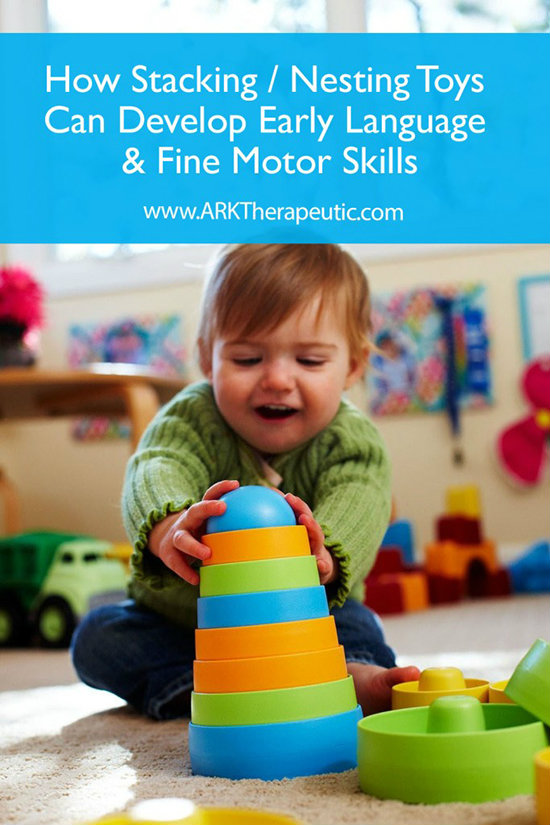How Stacking / Nesting Toys Can Develop Early Language and Fine Motor Skills
18th Mar 2014
Stacking toys - Oh how I love thee! Let me count (and stack) the ways. Don't be deceived - these seemingly simple toys pack a big punch when it comes to early learning development. How do stacking/nesting toys aid in the development of fine motor and language skills? Here's how you can play to learn with these classic toys:
.

.
FINE MOTOR SKILLS
There are many benefits of stacking cups for toddlers. For young children, picking items up and putting them in place helps them learn the important skill of intentional grasp and release, as well as how to control and position their fingers. Since infants don't have the dexterity or fine motor control yet, they use their entire hands to explore, hold, release, and place objects. This means that larger, chunky shapes like the one in the picture above (Green Toys Stacker) are just the right size for little ones to grasp. Have your toddler start with the biggest pieces, progressing to the smaller pieces. And remember - they don't have to use all of the pieces at first. Later on, children can progress to using the center posts to pick up and move the pieces. Since these have a smaller circumference, they require a finer, more controlled grasp.
.
VISUAL AND SPATIAL PERCEPTION
Stacking/nesting also works on depth perception, hand-eye coordination, and understanding where your body is in space. As you put each piece on top of the other, you have to visually gauge where to place each piece both in relation to yourself, and in relation to the other pieces. For younger children, nesting toys are easier to start with. Since the pieces "sit" / lock into the other pieces, their design is more forgiving and offers more guidance in the early stages of visual perception. Traditional (non-nesting) building blocks build upon (pun intended) this skill for older children. These sets require graded control and pressure as you balance pieces on top of each other so they don't fall over.
.
BALANCE, TRUNK CONTROL, & GROSS MOTOR
Starting at about the age of 6 months and up, babies are gaining the postural stability to be able to sit up by themselves. They're also working on coordinating their movements. Sitting up while stacking allows babies to get used to stabilizing their core as they move about and use their hands. This early multi-tasking activity also gives them the opportunity to let their body "catch itself" and make adjustments to maintain balance (these are known as protective responses).
.
CROSSING MIDLINE
Crossing midline is the ability for the right hand to cross over the center of the body to function in the left hemisphere, and vice versa. This is an important skill for handwriting, cutting with scissors, reading, eating, and anything that requires the hand to move from left to right or right to left. To practice this skill, place all of the pieces on the left side of the body, next to the left hip. Have the child reach over with the right hand to grab a piece and then set it down either in front of them or to the right. Make sure that the child is using ONLY the right hand, without using the left hand to assist. You can see a video of this activity here (and learn more about how trunk turning can also help promote the oral motor skill of tongue lateralization).
.
LANGUAGE CONCEPTS
When it comes to working on language skills, keep in mind that you can use almost anything as an opportunity to learn new words and concepts, and stacking toys are no exception. Before you start, let kids knock all of the pieces over or dump them out of the box. Kids love to dump!! They usually don't get to, so you'll immediately catch their attention. They have to clean it up when they're done, but they can dump and make a mess until then. Now that you've lured them in:
• Use the different sizes to work on comparisons. Put the smallest and the largest pieces next to each other to teach big versus small. Throw another piece into the mix to work on big, bigger, biggest.
• Stack three pieces together to start working on the concept of sequencing and what comes next. If the child is having trouble with visual perception skills, focus on just two at a time. Put the smallest piece on top of the biggest one first, as these two are the most visually different. In time, incorporate the other pieces. Then stack a set, but with one of the pieces missing. Have the child identify where the missing link in the sequence is.
• Use this as an opportunity to work on colors/matching, top/bottom, counting, etc.
• Work on turn-taking skills by letting the child stack a piece, then you, and so forth. Or tell them a particular order to stack them in to work on following directions.
.
CREATIVE PLAY
There's no one way to play. Kids naturally think outside of the box, so encourage them to look for alternative uses for whatever's at hand. Have them make up a game with the various pieces, let them create a story around whatever they've built, etc. This exploratory activity will foster their creativity and problem solving skills. For example:
• Stack the pieces upside down.
• If the pieces are rounded, turn them upside down and spin them.
• Or turn the pieces on their side and roll them. "Oh noooo! It went OUT of the door or UNDER the table" (another opportunity to work on prepositions).
• Play games á la "Who's Line Is It Anyway?" Pretend the pieces are a clown nose, hat, goggles, bug eyes, and so on.
• If the stacking pieces are hollow, turn them upside down and use them as containers to sort pom poms with or without a tweezer. Bonus points if you sort them to match the colors of the pieces. You can also put a few cheerios or m&ms in the cups and have the child retrieve them for as a tasty incentive.
• Or use the pieces to scoop and pour water for bath time fun, to scoop beans, rice, water beads, etc. during sensory play, or as molds to make sand castles.
.
Have fun and enjoy!
.

